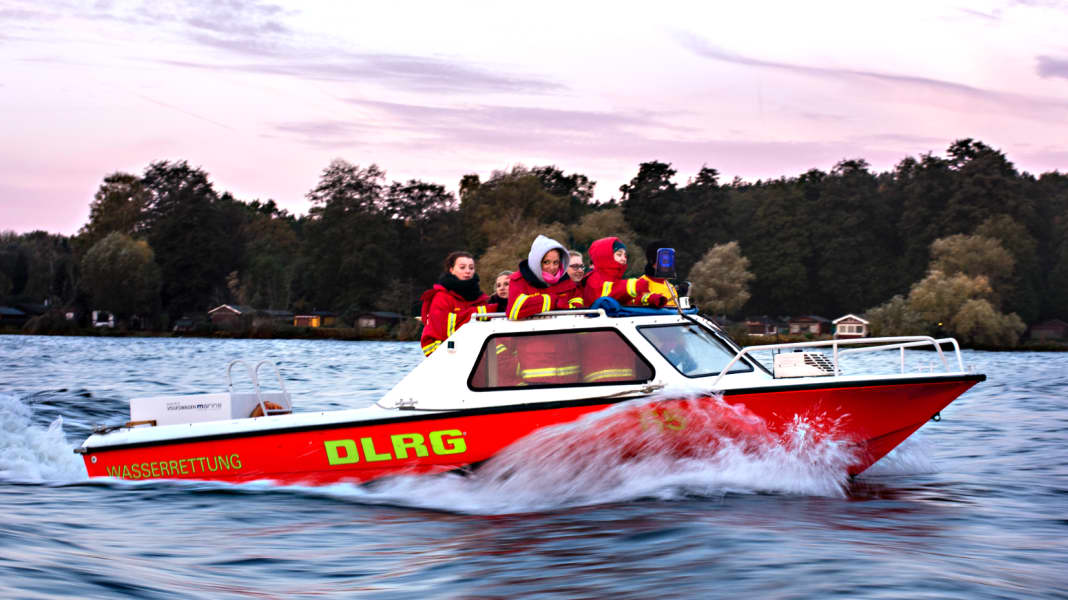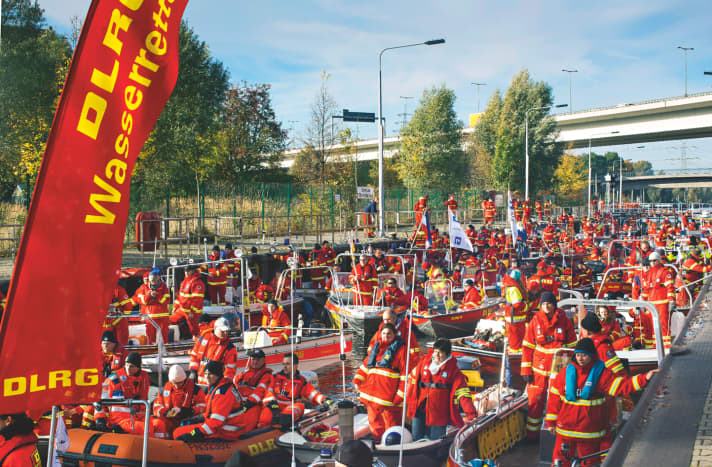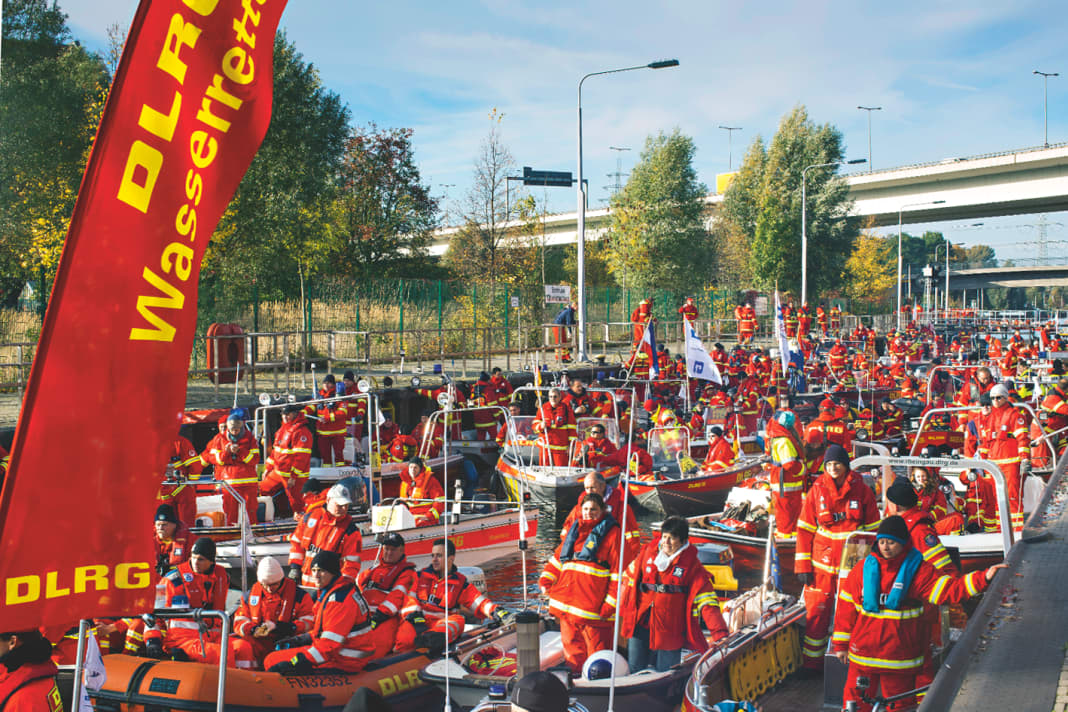







Saturday, shortly after half past seven. The horizon begins to shimmer in the east. The thermometer shows 4 °C, the air is clammy. A lone rower crosses the lake. It's late in the year, almost the end of October. The sky is now glowing in the colours of the morning: purple, red-orange, gold. "Fits!" says one of my fellow travellers, who, like everyone else here, is wearing signal red functional clothing with yellow "DLRG" lettering. All of them?
I look enviously at the professional outfit. I'm wearing an onion look and I'm cold. We're on our way from Großer Wannsee to Pichelsdorfer Gemünd with a whole fleet of lifeboats. From there, we're supposed to continue on to Berlin city centre. The rowers pause. "I didn't realise you had so many boats!" says one. "There'll be more, like fifty or sixty," our skipper calls back and adds, a little cockily, "You only get to be a hundred once!" The rowers smile and I turn up my collar. That little bit of cold. Today marks the centenary of the German Life Saving Association (DLRG). You don't want to be a wimp.
This boat demo through Berlin is part of the festivities. The project has been in the works for more than a year. Over a thousand participants and supporters from all over Germany have registered and around 200 lifeboats have been notified. Around 150 colleagues from the DLRG Berlin regional organisation are on hand to help. Two days before the big event, the really hot phase has begun.
Team after team arrives at the Wannsee lido. This is the central check-in station. The skippers receive all the necessary information and the boats are accredited. Around the clock. Some DLRG members therefore sleep in the organisation office. If a newcomer rings the bell at night, someone has to go out and brief their mate.
That's the way it is among volunteers: Many can only pack their bags after work, hitch up the trailer and set off for Berlin. If you have a long journey, you arrive late at check-in. It goes without saying that you don't leave your mate on the doorstep. Many want to camp. The organising team has to allocate them a pitch, even if it's late at night.
Slumbering without a warming stove. This is not allowed on the lido grounds. Are DLRG people tough? Michael Neiße from the DLRG regional association in Berlin grins: "Normally they are tough. If they have the right sleeping bag ..."
Michael Neiße was born into the DLRG, so to speak. "I was allowed to play on the beach while my parents were on duty," he recalls. In the meantime, the third generation has joined the DLRG, Neiße's 15-year-old daughter. Well over 60 per cent of all DLRG members are under 26. The fact that a number of active members bring their children with them and that the offspring of others can also become acquainted with the DLRG at an early age, virtually through baby swimming, makes things easier, but does not yet bind them.
What ultimately makes children stick with the organisation well into adulthood is something else - the combination of fun and substance. Because partying and commitment are always close together. "And that's what we tell the young people when they start here," emphasises Michael Neiße, "that it can get very, very serious from one second to the next." However, it is precisely this mix of engaging interaction and meaningful activities that strikes a chord with young and old alike.
Twelve hours to go until the parade. Michael Neiße gives the participants final instructions. Tomorrow we start from Strandbad Wannsee in the direction of Pi-chelsdorfer Gemünd, where more lifeboats will join us. Once the convoy has formed up, we will pass through the Charlottenburg lock, then via the Spree to the Berlin-Spandau shipping canal and back to the Spree via the Charlottenburg connecting canal. A party will be waiting for us at Charlottenburg Palace. Immediately afterwards we will start the return trip. We have a total distance of around 61 kilometres ahead of us. "Please follow the instructions," Michael Neiße tells the boatmen, "so that we all have a nice trip ..."
Saturday, the big day has arrived. And I'm sitting on the back seat of the command boat with my nose frozen red. Just ahead, the Pichelsdorfer Gemünd comes into view, along with a rubber duck. It's forty times the size of a standard duck and sits on a pontoon boat with 60 hp under its rump. The yellow duck, symbolising safe swimming, makes the motto of this boat demonstration even more striking: "Safety for our children - against the closure of swimming pools."
The command boat is a 190 hp Windy 22, which has been working tirelessly for 42 years. "Absolutely suitable as a command boat and rapid response boat," enthuses skipper André Günther, DLRG head of operations for "SüdOst", i.e. the Berlin waters in the Köpenick area. The Windy also has a "second function": as an emergency doctor boat. Because André Günther is an emergency doctor. Like many, he joined the DLRG at an early age, at 13. "It's my hobby," he says. On a voluntary basis? "Of course!" he replies immediately, and I think I notice a brief shake of the head. What a question, too. And, yes, free time is scarce. "But I like to spend it wisely," emphasises André Günther. He learnt boating from the DLRG, and he learnt it really well. Motorboats are the organisation's most important means of rescue and must be fully mastered in an emergency.
"Do what you want, I'm bored," shouts a DLRG organiser, exasperated. It's 9 a.m. and the chamber of the Charlottenburg lock is filling up with lifeboats. Not every helmsman adheres to the meticulously laid out lock plan. This is necessary so that the 200 or so boats in the convoy can pass through in two hours as planned. It's a case of persuading the timid to move up and slowing down the pushers. In the end, it all works out as planned. Whether "Sabine", "Friedel" or "Wasserfloh" - shortly after eleven, all the boats are floating in the upper water of the lock.
Traffic jam, nothing works. With so many boats, it takes time for everyone to get sorted again. Someone is passing around layers of salad. What do rescuers actually do when there's nothing to save? "Basic and advanced training with the young comrades," says André Günther. And then he adds with a wink: "Of course, when the weather's nice, one or two of our comrades sometimes fall into the water ..." In the boat next to us, Lucy and Mira look out of the starboard window, mesmerised. On land, one of their fellow fish is lifting its leg.
Lucy and Mira are rescue dogs and travel on the "Schwabenstolz". The cabin cruiser belongs to the Gundelsheim local DLRG group. The crew travelled from the Neckar to the Spree on their own keel. They had been travelling for seven days. - Suddenly there is excitement. A boat in front of us is full of water. "Have you sprung a leak or what's going on?" shouts a DLRG helper. No hole in the hull, the 4 metre long "Jöö 2" from Bottrop has caught a wave. Colleagues have already gone alongside and provided first aid: Towing package built, pump installed, trimming instructions given. The commands come clearly and distinctly. Soon the "Jöö 2" can rejoin the convoy.
We are at the main station. Now there really are a lot of people waving at us - attention that the parade deserves. After all, the action is a demonstration against pool closures. Fewer pools means fewer swimming lessons, less training means more non-swimmers. A fatal development.
At the beginning of the 20th century, barely three per cent of Germans could swim. At that time, around 5,000 people drowned every year in the German Empire - statistically 14 a day. Then a tragedy occurs that shakes people awake.
It is 28 July 1912 and a glorious summer Sunday is drawing to a close in Binz on the island of Rügen. Countless bathers and onlookers stroll along the pier. The jetty in front is besieged by day-trippers. The "Kronprinz Wilhelm" is about to moor here. But then a beam buckles. The jetty breaks and pulls dozens of people into the sea. Most of them are non-swimmers, as are those standing on the bridge. They can only watch helplessly as men, women and children fight for their lives in the water. Naval vessels are moored nearby. Crew members observe the drama, jump into the Baltic Sea and rescue many of the casualties. For 16 people, however, all help comes too late. They drown.
The following June, the German Swimming Association published a fiery founding appeal. "Learn to save! must become our main slogan," it says, "We must bring about the planned training of everyone, including women ..." On 19 October 1913, the time had come. The DLRG is constituted in the Leipzig hotel "De Prusse". A lot has happened since then. Today, non-swimmers are the exception rather than the rule. The number of drownings per year has fallen by 92 per cent compared to 1913. An achievement that the DLRG, together with other organisations and rescuers, can take credit for.
Exactly one hundred years to the day after the DLRG was founded, on 19 October 2013, the boat parade winds its way through the city of Berlin. At midday, we pass Charlottenburg Palace once again. People applaud on the riverbank. Some of them have just come from the ceremony in the palace's Great Orangery. The patron of the DLRG, Federal President Joachim Gauck, has just spoken there. "The ideals and work of the DLRG are also a model for society as a whole: developing skills together to support each other, look out for each other and protect each other," he said. With this in mind, here's to the next hundred years, German Lifesaving Association!

